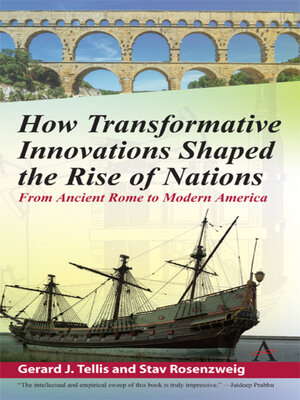How Transformative Innovations Shaped the Rise of Nations
ebook ∣ From Ancient Rome to Modern America
By Gerard Tellis

Sign up to save your library
With an OverDrive account, you can save your favorite libraries for at-a-glance information about availability. Find out more about OverDrive accounts.
Find this title in Libby, the library reading app by OverDrive.



Search for a digital library with this title
Title found at these libraries:
| Library Name | Distance |
|---|---|
| Loading... |
Over the last 2,000 years, critical innovations have transformed small regions into global powers. But these powers have faded when they did not embrace the next big innovation. Gerard J. Tellis and Stav Rosenzweig argue that openness to new ideas and people, empowerment of individuals and competition are key drivers in the development and adoption of transformative innovations. These innovations, in turn, fuel economic growth, national dominance and global leadership. In How Transformative Innovations Shaped the Rise of Nations, Tellis and Rosenzweig examine the transformative qualities of concrete in Rome; swift equine warfare in Mongolia; critical navigational innovations in the golden ages of Chinese, Venetian, Portuguese and Dutch empires; the patent system and steam engine in Britain; and mass production in the United States of America.
|The first thesis of 'How Transformative Innovations Shaped the Rise of Nations' is that economic growth, national dominance and global leadership are fueled primarily by embracing innovations, in particular transformative innovations.
A transformative innovation is one that changes the lives of people, reshapes the structure of society, disrupts the balance of power within and among nations, and creates enormous wealth for its sponsors. The adoption of a transformative innovation spawns numerous other related or consequent innovations. It provides a competitive advantage to a nation and may propel a small, backward region to world leadership in as short a time as a century. Further, the transformative innovation can sometimes itself promote the positive environment that leads to further innovations. Thus, embracing innovation can start a positive cycle of wealth creation, economic dominance and a positive environment for further innovation. This positive cycle continues as long as the environment that spawned the innovation remains supportive or until another transformative innovation arises elsewhere.
The second thesis of 'How Transformative Innovations Shaped the Rise of Nations' is that innovation is not adopted randomly across time and nations. Rather, it is sustained by an environment characterized by key institutional drivers within a country or region, three of the most important of which are openness to new ideas, technologies and people, especially immigrants; empowerment of individuals to innovate, start businesses, trade and keep rewards for these activities; and competition among nations, patrons, entrepreneurs or firms. Geography, resources, climate, religion and colonization probably played a role as well. However, past treatments of the rise of nations have overemphasized the role of these other factors; they have downplayed or ignored the role of innovations and the institutional drivers that led to their development and adoption.







